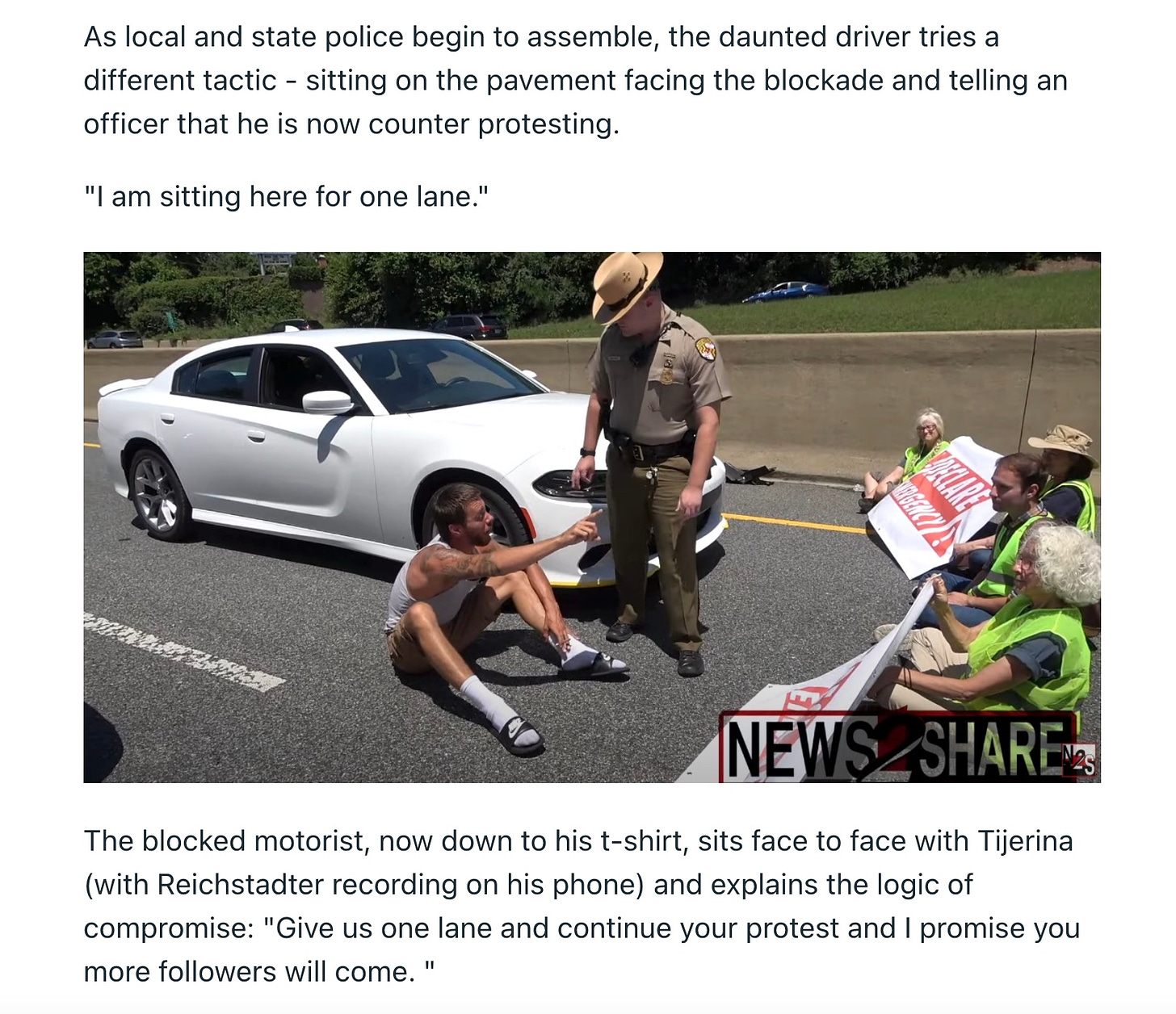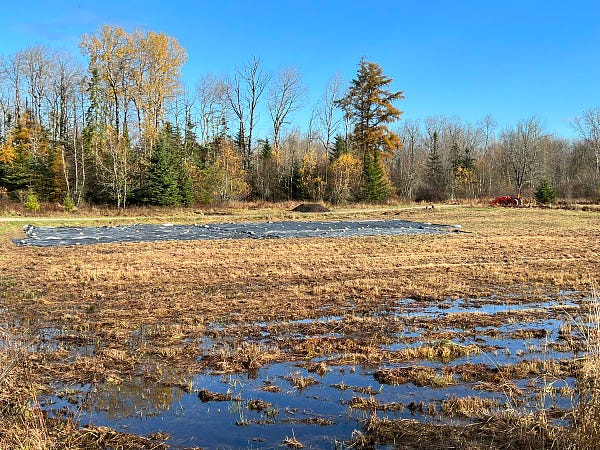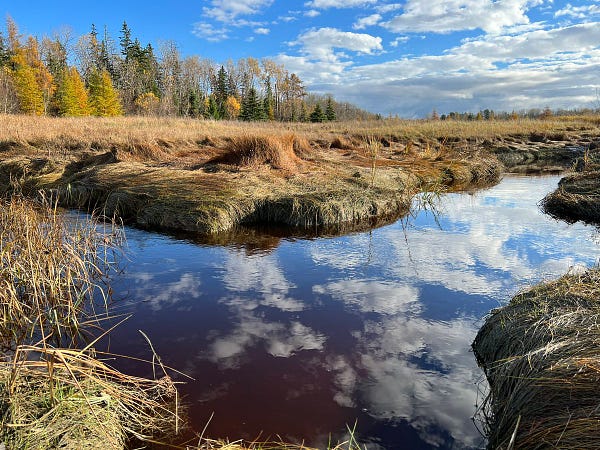📺 ☝🏽 Listen to longtime activism researcher Dana Fisher describe what she found when the U.N. Intergovernmental Panel on Climate Change asked her to gauge the carbon impact of climate activism. The full video conversation with Fisher and two other authors is below.
Welcome to the new Substack iteration of my Sustain What project, which builds on nearly 40 years of prize-winning environmental journalism and aims (at least weekly) to offer a dose of sanity and substance in a world of yes/no debates. Explore subscription options here.
Going to climate-action extremes
UPDATE: Watch the Sustain What episode on next steps for in-your-face climate protests, with journalist Gaia Vince, climate-activism thriller writer Mark Alpert and laughtivism practitoner Igor Vamos of the Yes Men (a k a Mike Bonnano):
Activism on the edge
In-your-face climate activism is nothing new.
I witnessed my first food-tossing protest while reporting from the fraught climate treaty talks in The Hague in late November 2000 (as the Supreme Court was weighing Bush v. Gore back home). That was COP 6 for those keeping count.
At a briefing, a woman leaped from her seat and planted a custard pie in the face of the lead United States negotiator, Frank E Loy.


Ever the diplomat, Loy dabbed at the contents and issued this statement a bit later: “On the eve of Thanksgiving, pumpkin pie would have been a more traditional choice, but what I really want is a strong agreement to fight global warming. I'm headed back to the negotiating table right now with that aim.”
The talks ended in deadlock - an outcome that had more to do with strong differences between Europe and the U.S. over the climate value of forests absorbing carbon dioxide than pie varieties.
Now all manner of things are being defaced, damaged or blocked in the name of stopping all oil and gas development in a world facing stark energy and food price spikes - and the relentless climate change challenge.
📺 i hosted a Sustain What discussion on where this extreme in-your-face climate emergency activism may be going, through the lens of climate fiction. Click here; learn about my guests below.
What’s different about the burst of extreme climate provocations in recent months - and especially the last couple of weeks?
For one thing, campaigners pushing the “climate emergency” message are doing so amid a confluence of intensifying worries over wildfires, deluges, heat domes and superstorms, the first real global energy crisis since the 1970s and the ever-growing clickstorm capacity of artfully-tuned social media.
European protestors, particularly, have built on the “Insulate Britain” campaign model, trying to mesh working-class anger over high heating costs with the longstanding environmentalist focus on Big Oil (and gas).
For another, the networks behind these assaults on famous artwork, car dealers, SUV tires and the rest (@a22network, particularly) have received an infusion of millions of dollars in donations from heirs to oil fortunes, Hollywood powerhouses like Adam McKay (@ghostpanther), and more. (Read Cara Buckley’s August deep dive for The Times on the Climate Emergency Fund and Equation Campaign.)


Here’s a breakdown of the debate and one insight that I think undercuts everyone’s stance:
Proponents, funders and protestors say they’re helping drive a vital conversation and nothing else has worked. Van Gogh soup splasher Phoebe Plummer made the point well via Free Seed Films: “It is ridiculous but we’re not asking the question should everybody be throwing soup on paintings. What we’re doing is getting the conversation going so we can ask the questions that mater.” Conversation started, for sure.
But some experienced researchers of edge-pushing activism warn of backlash when marginally-engaged audiences see destruction, disruption and recklessness. Read “The Activist’s Dilemma.” Watch the Vermeer attack from Thursday and tell me something constructive will result.
Other critics say high-profile attacks on art and Porsches distract from the need for forms of activism that can directly help people in harm’s way now. I’m in that camp, but Currently managing editor Zaria Howell (@earthtozaria) nailed this point better than I ever could.
But some social scientists say it’s not clear what will come of all of this, for better or worse. When asked by the U.N. Intergovernmental Panel on Climate Change to summarize research gauging any impact of climate activism on trends in planet-heating emissions, University of Maryland sociologist Dana Fisher (@fisher_danar), concluded that there wasn’t much to summarize.
Science comes up short gauging if climate protests matter for climate change.
The video clip from Fisher at the top of the post is from an August 2021 Sustain What webcast, well before the latest spasm of provocative art-targeting climate activism, in which she and two other IPCC authors, Ed Carr and Paul Edwards, described their work. You can watch the full fascinating hour here: “Code Red for Humanity” – Now What? Meet IPCC Scientists Working That Problem.” A rough Trint transcript is here.
But here’s the section most relevant to the question of the moment: is it possible to measure any carbon impact of climate activism?
Here’s some of what Fisher said:
“There's so much discussion right now about these bottom-up efforts to pressure policymakers at the local level, at the state level, at the national level, at the international level. I've actually been studying the role of civil society at these multi levels since the nineteen nineties through the Kyoto process. And one of the things that the IPCC asked me to do, which I found really challenging, was to measure the carbon impact of activism and engagement.
As social scientists, we think about it completely differently than when I'm in the climate world and talking to the climate world, [where] everybody's like, oh, it's great. Go pressure, go lobby, go bird dog. Well, what does it actually mean for climate?”
Her research review, with Sohana Nasrin, ended up published in Wires Climate Change and was heavily distilled in chapter 13 of the Working Group 3 report of the IPCC (the one on solutions). There’s tons of research measuring movements, but not a lot on impacts.
Fisher added:
“They made me cut most of it because it didn't actually have any relationship whatsoever to actual climate in terms of carbon or any greenhouse gas. So I then went looking for the research that exists that helps us to think through what does it actually mean for carbon if you write a letter to an elected official or you participate in a protest? And so that's something that's driving a lot of my work right now.”
In our conversation, I said this knowledge gap - on what is, or can be, known about climate activism impacts on climate - reminded me of of a great line from "The Little Prince” - “That which is most essential is invisible." For sustainability, perhaps, I said, “That which is potentially most important seems really hard to measure.”
Fisher replied: “It is. It's not in the models, as you guys know better than me. And it's something that we have to measure, particularly when there are these global calls for activism. I mean, there's going to be another climate strike, another Friday for Future global strike.... But what does it actually mean? There are all these claims about the effectiveness of protests and activism. But just because you're successful in getting somebody who you expect to be a climate champion elected doesn't actually mean that it has any effect on climate change. “
I asked: “I've got to ask you, is this something that activists fear? Do they not want to hear the results?”
Fisher: “That's a good question…. So far I haven't heard that. Honestly I'm not sure that this conversation and this question has really gotten out into the general public yet. I think everybody just thinks you get a lot of people in the street yelling, maybe put a pink hat on them and it'll make a difference, right?”
And now here we are with scads of activists in the streets. Things could get even crazier in the days ahead in the run-up to the COP 27 climate treaty conference next month in Egypt. Just don’t look for much protest on the ground at the venue, given the human rights record of the current regime, as Naomi Klein (@naomiaklein) warned in a Guardian column headlined “greenwashing a police state.”
To get deeper into the motivations of the current crop of monkey-wrenching climate-emergency campaigners, on October 17 I invited Fisher back, along with the sociologist Robb Willer (@robbwiller) of Stanford University (an author of that “activist’s dilemma” paper above) and Margaret Klein Salamon (@climatepsych), executive director of the Climate Emergency Fund, a top bankroller of soup tossers. We were also joined by longtime performance activist “Reverend” Billy Talen. The result was a boisterous but productive Columbia Climate School conversation.
How climate soup tossers are losing and winning
Klein Salamon said the demonstrations are doing what funders want:
“These demonstrations work because they recruit people, which is ultimately what the movement needs to do. I know that the vast majority of people hate the activists and are so angry about this. Okay. But we can still recruit the visionaries - the people who are done with normal mode. And guess what? There's more and more of them.”
Watch on YouTube here or watch and share on Twitter, LinkedIn or Facebook. You can also sift a (very) rough transcript here on Trint. (If you choose a paid subscription level that can help me hire someone to produce clean transcriptions!)
If you’re an ears-first content consumer, here’s the audio podcast of the discussion.
Updated: I offer my personal takeaway from all of this below. But first, more on today’s show. At 1 p.m. Eastern today, I hosted another relevant Sustain What conversation, using the window offered by climate fiction to gauge where this pulse of activism might all be going. Watch here and above.
We’ll explored whether food-splattered paintings and roadblocks could be a prelude to darker actions. One guest was the former Scientific American editor Mark Alpert, who’s now building a career as a thriller writer, with his latest book “The Doomsday Show,” centering on climate terrorists kidnapping fossil fuel executives (and doing worse). He’s also contributed to the Climate Parables short story project of Anthropocene Magazine.
Also joining us was veteran science writer and author Gaia Vince, whose new book “Nomad Century” tracks forecasts of global dislocation that have fueled another kind of extreme climate activism - the longtermism philosophy thrilling Silicon Valley and horrifying others.
All hail “laughtivism”
Finally, I was thrilled to reconnect with Igor Vamos (a k a Mike Bonanno), one of the dynamic duo behind the Yes Men project that’s been pulling potent pranks on corporate powers that be more than two decades.
I’m a big fan of the Yes Men, whose operations are more about what they call “laughtivism” than pissing off average citizens. Their website is full of advice that the current crop of protestors might benefit from.
My Takeaways
A hollow basis for extreme behavior
Members of this climate fringe defend their actions as in service of avoiding mass casualties ahead. Listen to my July interview with one of the Declare Emergency D.C.-area road blockers to absorb the self righteousness.
For the most part these extreme campaigners have bought into an end-times vision of climate breakdown that has little relationship to what climate science has revealed. As I’ve written too many times, data show clearly that, in most cases, what’s cast as a global climate emergency is mainly hundreds of local vulnerability emergencies - in places rich and poor. Read here and here for starters.
It was heartening to see James Ozden (@jamesozden), a communications and strategy consultant on social campaigning, recently point out more than a dozen errors in incendiary recruiting talks by Roger Hallam (@rogerhallamCS21), a founder of Extinction Rebellion, who says his two priorities are “to tell the truth and to act as if it’s real.”
Maybe input from Ozden and others will prompt some changes. But I wouldn’t count on it because, as behavioral science has powerfully shown, it’s rational to be utterly irrational when an issue gets deeply polarized. It’s more adaptive to hang onto the story line of your peers than to be pulled away by facts.
~ INSERTED Feb. 8 - A young climate activist, Zion Lights, has done a brave public service by writing about her personal experience being sucked in by - and escaping - the tactics of climate doom preachers. Read her new Substack post on this here: In an era of eco-anxiety, how do we protect young people from the lure of doomerism?
And here’s an earlier iteration:


~ End INSERT ~
Read up on what longtime researcher Dan Kahan at Yale Law School calls “cultural cognition” for more on this.
I would be a science denier if I thought I might shift their baseline source of anxiety.
Let the wild rumpus play out
I’ve long pointed to the inevitability and deep logic of “response diversity” facing an environmental stress. This concept emerged in a remarkable 2003 paper on the sources of ecosystem resilience by Thomas Elmqvist of Stockholm University and others. It included this line:
The diversity of responses to environmental change among species contributing to the same ecosystem function, which we call response diversity, is critical to resilience. Response diversity is particularly important for ecosystem renewal and reorganization following change.
As I read it, I pondered whether the following slight tweak might also be true:
The diversity of responses to environmental change among people contributing to the same social function, which we call response diversity, is critical to resilience. Response diversity is particularly important for social renewal and reorganization following change.
Given that there’s no way yet for someone to win an argument on whether activism of this sort matters for climate, and given that response diversity is inevitable and probably a good thing, who am I to rain on Just Stop Oil’s parade?
No one really knows where this is all going.
Every time you see someone offering a “theory of change,” as with the prank-financing Climate Emergency Fund here, know that it is more an untested hypothesis than an established theory. (As we all know, the word theory is often abused, as Carl Zimmer nicely explained awhile back.)
Of course that means those saying these protests are surely counterproductive have no basis for that assertion either.
At the same time, these extremists and their funders would do well to modulate things a bit.
I think a diagram posted on Substack by James Ozden nicely captures the reality. There’s a sliding scale of tactics and outcomes within what’s been done so far, and will be attempted in the weeks ahead.
I wish that notion, of a sliding scale of reasonableness and impact, would be better integrated into the decisions made by these groups and their funders.
I encourage you to subscribe to Ozden’s newsletter and read the two pieces he’s posted so far on the soup saga:
What’s everyone got against throwing soup? (posted October 22, the day of the Van Gogh smear)
Why I could be wrong about SoupGate (October 22, the one with the diagram)
Back in July, after one of the D.C.-area rush-hour roadblocks by Declare Emergency led to the arrest of a late-for-work parolee, I tried to amplify his completely legitimate plea to the demonstrators to “open one lane.”
They refused. This delayed driver freaked out, was carried off to jail and his life may well have been ruined.
My main message to these groups was open one lane - or do the equivalent - if your goal is actually to provide a “radical flank effect” - edge pushing that drives people to engage with more reasonable factions.
If your goal is disruption as a way to build a mass movement, good luck with that using such tactics.
Opportunity cost
My biggest beef with this array of edge-pushing pranksters is not with their targets; it’s with what they obscure by giving the climate media and social media mill a crack-strength dose of what it craves - clicks and controversy.

Left out of the conversation that soup tosser Phoebe Plummer said was happening are the forms of activism and communication that can directly improve the lives of people down the block from you, or communities around the world, whose vulnerability to existing climate hazards is a function of poverty or prejudice.
Please do read the essay posted on the day of the Van Gogh assault by Zaria Howell, the managing editor of the Currently weather news site. She eloquently conveyed an essential problem with these actions - the opportunity cost they levy by taking attention away from actions that can be taken now to improve lives of those placed in harm’s way by poverty or prejudice:
Here’s the follow-up question I’d ask, is the incessant need for the climate movement to be validated by apathetic stakeholders overshadowing addressing the needs of vulnerable communities?
This question is rhetorical. The answer is yes, and the solution is to regain focus, and re-commit, to what really deserves our attention: defunding fossil fuels and investing in community resiliency and climate adaptation.
There’s an enormous amount of work to be done at the local level everywhere to build a safer relationship with climate for everyone.
It will also take a fresh form of activism to make sure those with the greatest need get access to the tens of billions of dollars in federal incentives, loans and other clean-energy programs created under the Bipartisan Infrastructure Law and Inflation Reduction Act.
Who is funding efforts to fill those gaps? I was in a recent conversation with folks from Rewiring America, the Sierra Club and Redwood Climate Communications that touched on what this can look like. This post explores the ideas:
The same is true for spreading resources and capacities boosting resilience to climate hazards where the vulnerability is greatest.
Read the post I wrote on how to build community climate resilience by widening the annual “great shakeout” exercise that those of you who live in earthquake country are familiar with:
And you can also make a difference at the global level by supporting organizations like the International Federation of Red Cross and Red Crescent Societies, which is working to boost distributed community capacity to cut climate-related losses.
Or you can glue yourself to the glass over a painting.
Thanks for reading, reacting, sharing!
Postscripts
I meant to include a link to an invaluable assessment of climate activism research by Colin Davis of the University of Bristol: “Just Stop Oil: do radical protests turn the public away from a cause? Here’s the evidence.” He writes:
“Dramatic protest isn’t going away. Protagonists will continue to be the subject of (mostly) negative media attention, which will lead to widespread public disapproval. But when we look at public support for the protesters’ demands, there isn’t any compelling evidence for nonviolent protest being counterproductive. People may ‘shoot the messenger’, but they do – at least, sometimes – hear the message.”
~ ~ ~
My posts won’t all be this long, by the way. Lots of ideas backed up as I make the transition from Bulletin to Substack!
Here’s a parting shot from Downeast Maine.














Amid Protest Debates, Researchers Have Yet to Measure the Climate Impact of Climate Activism (Which Doesn't Mean it's All Bad)